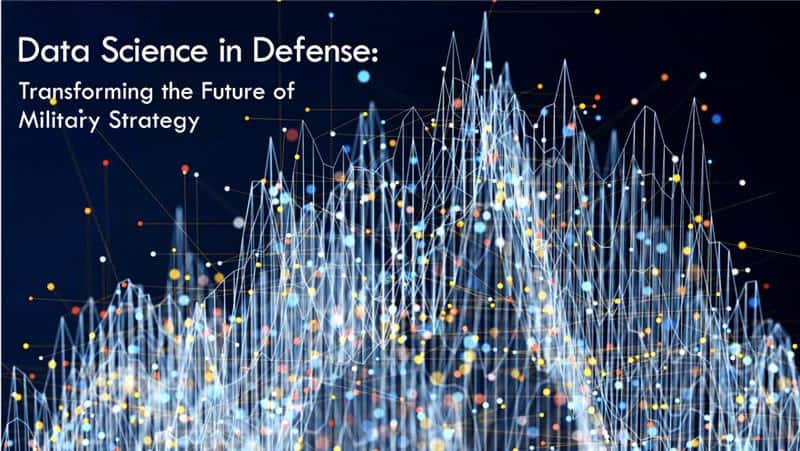
Data Science in Defense means applying data and intelligent computer programs to make soldiers safer, more efficient in their decisions, and to secure the nation better.
Think about it like this: these days, every aspect of a military operation —whether it’s deploying a drone, monitoring a border, or conducting cyber defense— creates a great deal of information. All of this information builds and accumulates: satellite photos, drone footage, skimming records, and even logistics. The question is, though: how do you go about interpreting it all?
That’s where data science in defense industry comes in. No longer is defense about firepower and numbers—it’s about data power. Using artificial intelligence and machine learning, defense industries & agencies can convert inundating, flood-like streams of unrefined information and data into insights during real-time, which, in turn, helps in saving lives and securing that nation.
Data Science in Defense is the need of Hour for all Nations
Instead of relying on more traditional approaches like relying on common sense, old reports, or only intermittent updates on intelligence, military forces, data science in conjunction with the field, can anticipate the risks in advance, thereby saving a great deal of resources, and further, can lessen the risks that are involved in the field. In short, digital intelligence is as essential as physical power.
And this transformation is not taking place just in high-tech countries. It’s taking place in developing nations as well, which are adopting data-driven defense methodologies to remain ready for contemporary threats. From enemy movement via satellites to predictive analytics indicating when equipment could malfunction, data science is increasingly becoming the backbone of defense strategies worldwide.
We gather all the necessary information regarding data science in defense. Let’s delve into more details to understand what data science in defense entails, including its core applications, future prospects, and the challenges associated with implementing data science in this field.
You can also read about the full-body haptic suit, a revolution in the tech industry.
What is Data Science in Defense?
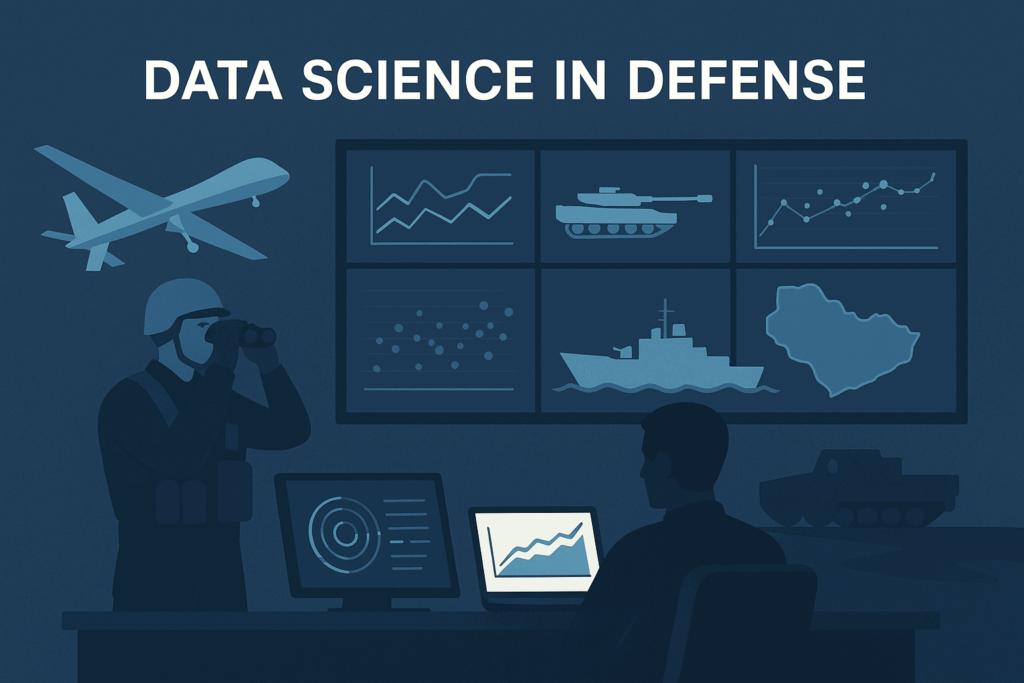
Picture the army, navy, or air force need to make extremely intelligent decisions on a daily basis. They process enormous amounts of information—such as radar signals, satellite images, maps, weather information, and even enemy movement reports.
Data Science is like the “brain tool” that assists the defense forces in taking all this data, sorting it out, analyzing it, and then identifying patterns or making predictions.
Data Science in Defense: Example
If a radar takes thousands of signals, it’s difficult for humans to examine them individually. Data Science uses computers and smart programs (algorithms) to quickly search through those signals and state:
- “This one is a bird.”
- “This one appears to be an enemy plane.”
- “This one is merely background noise.”
So, rather than make a guess, the defense teams receive unambiguous, data-driven answers quickly.
Everyday Applications of Data Science in Defense:
Attack Prediction: By analyzing historical enemy activity, data science can predict where and when the next one will occur.
Intelligent Maps: It can build real-time maps of safe and unsafe zones.
Equipment Maintenance: It alerts when tanks, aircraft, or vessels are in need of repair before they malfunction.
Cybersecurity: It assists in locating and preventing hackers attempting to infiltrate military computers.
Read More: What are AHRC Business Links – UK and New York Explained 2025
Evolution of Data-Driven Defense Systems
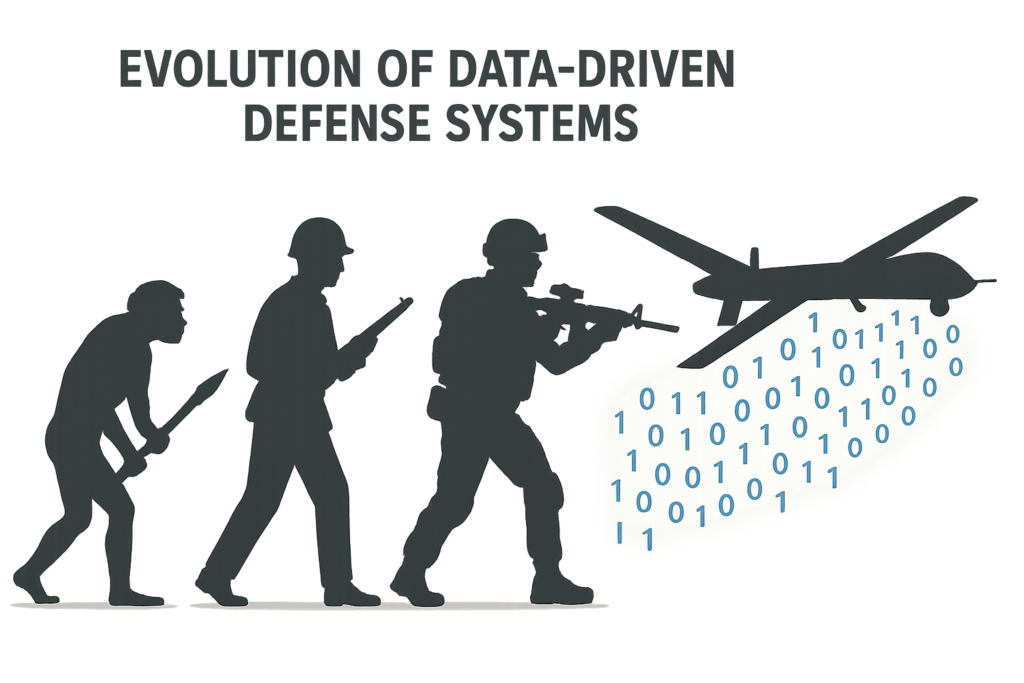
The history of data-driven defense dates far back. Militaries used to depend on human spies, reconnaissance aircraft, and overheard radio messages in the past. The issue? That type of intelligence tended to be slow, limited, and occasionally in error.
Things began to shift back in the Cold War days, when early satellites and rudimentary computers became a thing. For the first time, defense forces could have access to digital intelligence, but still, it was nothing like what we enjoy today.
By the end of the 20th and beginning of the 21st century, the game had entirely shifted. Digital technology spawned a tsunami-like deluge of data—from satellites and sensors and drones and cyber networks. Old-fashioned ways couldn’t cope, and that is where data science came in. Machine learning, artificial intelligence, and big data analytics became the weapons of defense for the future.
Defense systems today, all over the globe, heavily depend on data.
For instance:
NATO and American defense forces employ AI-enabled platforms for missile defense and real-time battlefield surveillance.
China’s armed forces are spending heavily in AI and data analytics to power cyber warfare and predictive intelligence.
This development proves one clear reality: data is the new ammunition. Just as nations competed to acquire nuclear capabilities, today it is a race for data dominance. The nation that gets best at data science will have the advantage in future wars.
Rise of Data Science in the Defense Industry
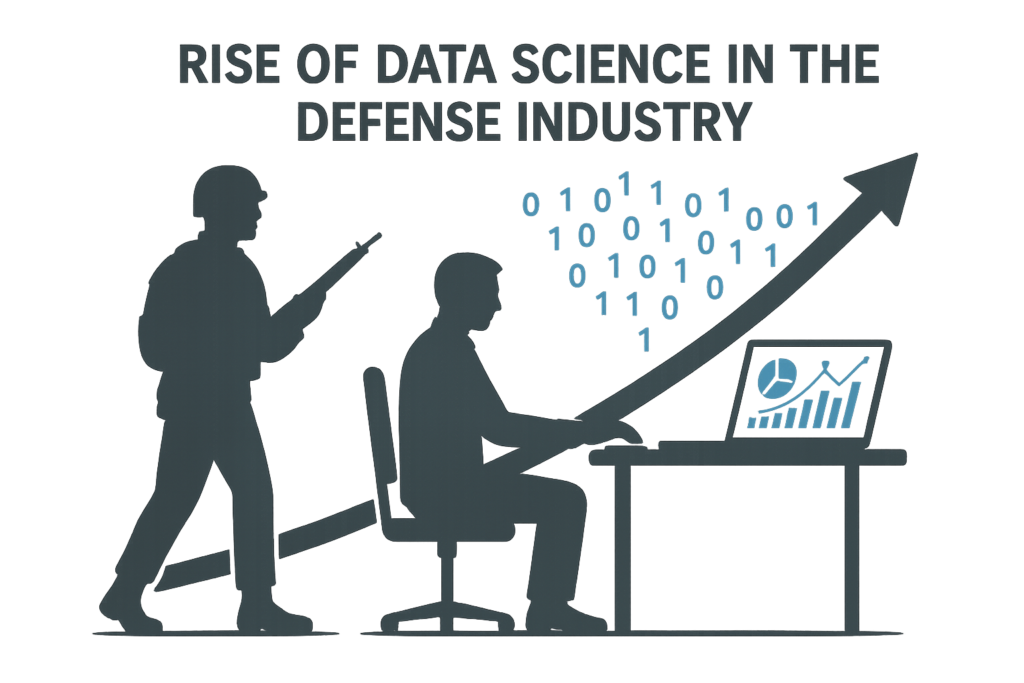
The role of data science in warfare today cannot be exaggerated. Combat today is no longer won solely on numbers and firepower. It involves the ability to gain and maintain information dominance. Commanders rely on real-time intelligence to estimate enemy actions, deploy assets, and act. Dum intelligence of any form would make the most advanced equipment irrelevant.
Transcending from Classic to Digital Battlefields
Old-fashioned warfare was highly dependent upon physical presence, brute strength, and military tactics. Although these are still relevant, online battlefields have become just as significant.
Warfare is increasingly being fought in the realm of cyberspace, where nations can be brought to their knees by stolen data, false narratives, and cyber attacks—without a bullet being fired.
Consider cyber warfare over a country’s power grid. A single focused attack on the defense comms network can immobilize a country’s military response.
Data science solutions allow defense agencies to identify patterns of anomalies, react to threats in real time, and protect key infrastructure.
In addition, virtual battlefields also include information warfare. Psychological warfare and operations today play a major role in any conflict. Defense organizations have the ability to monitor and mitigate the real-time spread of misinformation using advanced social network analysis, looking specifically to attack emotions and actions at the right moment.
Enhancing Predictive Decision-Making
In war, one has to make quick and precise decisions. Predictive analytics driven by data science gives military commanders an edge. Predictive models, analyzing past trends, battlefield terrain, and adversary actions, can predict future situations.
For example:
New enemy troop movements based on satellite and drone monitoring information.
Estimating chances of equipment malfunction under hostile environments.
Predicting supply chain dislocations during war.
This predictive ability lowers uncertainty, raises readiness, and minimizes risks. In some sense, predictive analytics is a military commander’s crystal ball, enabling him or her to plan for several scenarios.
Applications of Data Science in Army, Air Force, and Navy
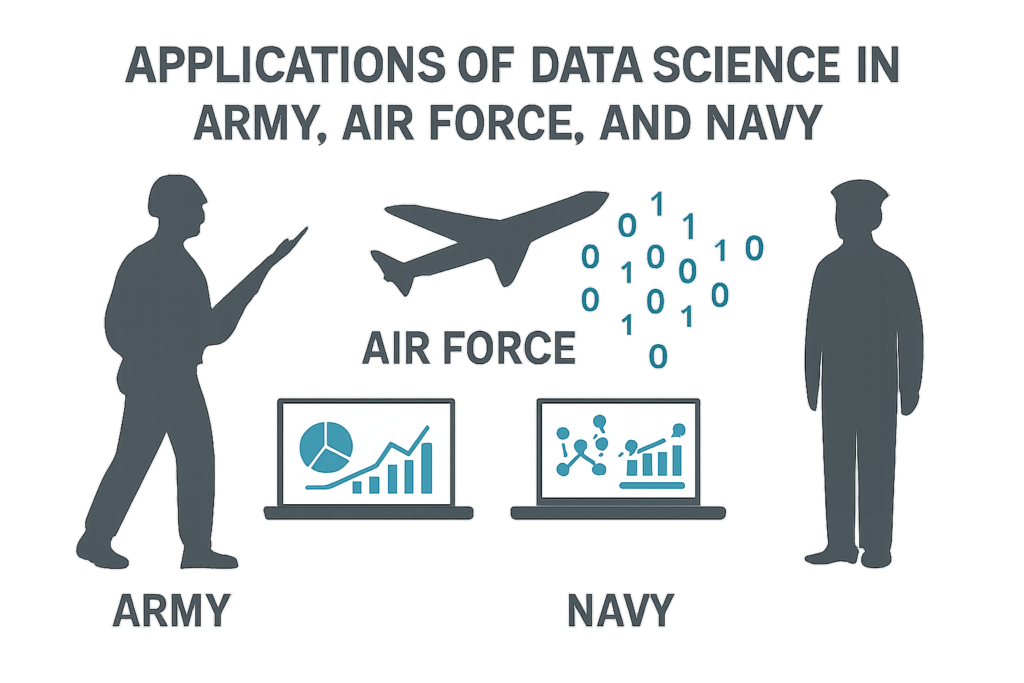
Data Science in the Army
Predictive Analytics for Threat Detection: The army has the ability to use data science to predict enemy troop movements, project insurgent attacks, and identify unpatterned activities on borders.
Battlefield Surveillance: Troops can be monitored and real-time situational awareness offered via drones, ground sensors, and wearable technology.
Supply Chain and Logistics: Army logistics are enhanced via predictive maintenance, the optimization of vehicle supply routes to isolated units, and AI-assisted resource distribution.
Data Science in the Air Force
Aircraft Predictive Maintenance: Sensors on fighter aircraft and transport planes input data into ML algorithms to forecast mechanical breakdowns ahead of time.
Flight Path Optimization: AI-based analytics can determine fuel-saving and safe flight trajectories in hostile regimes.
Air Surveillance and Targeting: Satellite imagery, radar, and AI-based recognition systems aid in identifying enemy aircraft, missile liftoffs, and camouflaged bases.
Combat Simulations: Machine learning develops realistic air combat simulations for pilot training, enhancing readiness.
Data Science in the Navy
Maritime Surveillance: Data science analyzes sonar, satellite, and radar data to detect enemy submarines, vessels, or illicit maritime operations.
Fleet Management: Predictive analytics maintains naval fleets efficiently, having ships repaired prior to breakdowns.
Route Optimization: AI assists navy commanders in identifying the shortest and safest sea routes, considering weather, enemy activity, and fuel consumption.
Autonomous Naval Systems: AI-controlled unmanned submarines and vessels are able to police waters, gather intelligence, and even fight with minimal human intervention.
Core Applications of Data Science in Defense
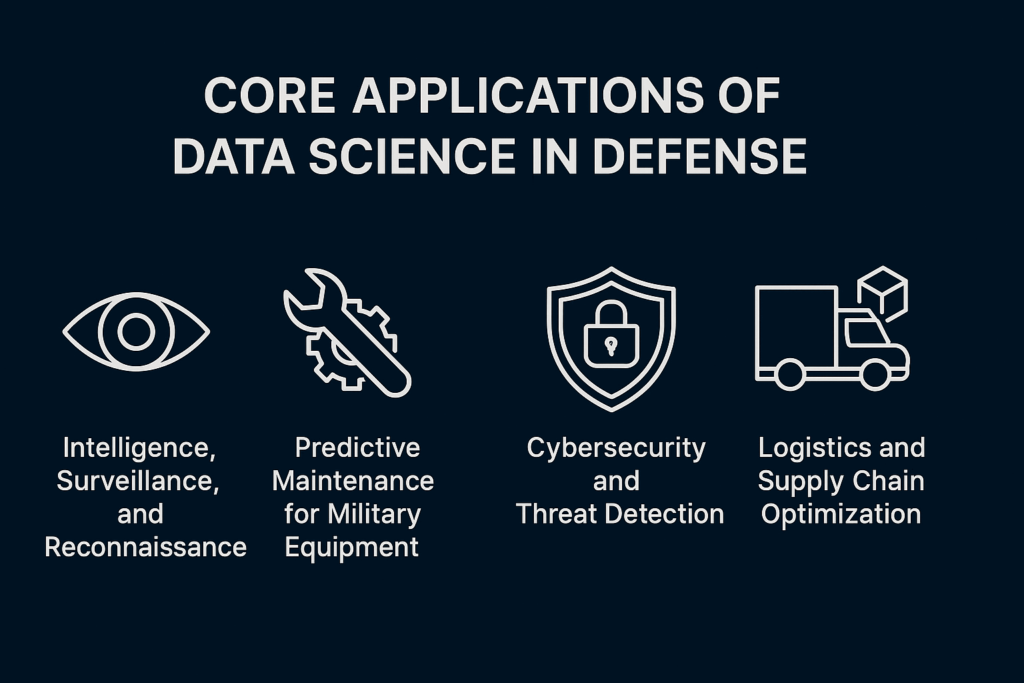
The defense sector has adopted data science in many areas. From intelligence gathering to logistics efficiency, data science touches almost every function of military operations.
1. Intelligence, Surveillance, and Reconnaissance (ISR)
ISR is the backbone of contemporary defense planning. In the past, ISR used reconnaissance aircraft and human agents. Now, it uses sophisticated sensors, satellites, drones, and AI-driven analytics to offer real-time situational awareness.
ISR systems can:
Inspect high-resolution satellite imagery to identify clandestine military establishments.
Track troop activities in real time by means of drone video.
Intercept and process communication signals to detect possible dangers.
The U.S. military’s Project Maven is a good example, employing machine learning to study drone video and automatically identify objects of interest. Such developments minimize the workload of humans while enhancing accuracy in intelligence evaluations.
ISR fueled by data science provides decision-makers with an ever-clear, data-driven vision of the battlefield.
2. Predictive Maintenance for Military Equipment
Perhaps the most useful and cost-effective use of data science in the defense sector is predictive maintenance. Military hardware, from aircraft and naval vessels to tanks and communications systems, must be regularly maintained to remain reliable. Militaries historically employed either scheduled maintenance (maintaining at set intervals) or reactive maintenance (fixing after failure). Both methods are inefficient—scheduled maintenance can be wasteful, while reactive maintenance can result in catastrophic failures in critical operations.
Data science addresses this issue by bringing predictive analytics into gear management. Defense agencies use sensors and IoT devices to capture real-time performance metrics from vehicles and equipment. Machine learning algorithms process this data to identify anomalies, forecast possible failures, and suggest prompt interventions.
For instance:
Fighter jets used by the military contain thousands of sensors that monitor engine performance, hydraulics, and electronic circuits in real time. Predictive models allow them to forecast when a component will fail and replace it before it breaks during a mission-critical flight.
Naval vessels use big data to track engine vibration, fuel usage, and weather impact to smooth out sailing on long missions.
Tanks and armored personnel carriers are also assisted by predictive diagnostics, saving time taken down in the field.
The Condition-Based Maintenance Plus (CBM+) program of the U.S. Air Force is an exemplary demonstration of predictive maintenance application. With the implementation of real-time analytics, the Air Force has been able to save billions of dollars while improving readiness for mission. In the same vein, NATO forces make use of predictive maintenance software to enhance the longevity of military hardware and reduce logistical cost.
3. Cybersecurity and Threat Detection
Cybersecurity is the most immediate challenge of contemporary defense. Military networks house sensitive data such as war plans, troop movements, and classified communication. One breach can jeopardize national security. With increasing cyber warfare, defense organizations use data science extensively to secure their digital infrastructure.
How Data Science Fortifies Cybersecurity?
Anomaly Detection – Data science models consistently monitor network traffic, searching for abnormal patterns like unknown logins, odd data transfers, or suspect file runs.
Threat Intelligence – Machine learning algorithms surf worldwide cyber threat databases to locate new viruses, malware, or hacking methods that may attack defense networks.
Real-Time Monitoring – AI-based systems offer 24×7 monitoring of military servers and communication networks, reacting in real-time to cyber threats.
Predictive Defense – Rather than reacting to cyberattacks, predictive analytics foresees possible vulnerabilities and fixes them beforehand.
One such instance is the U.S. Cyber Command, which employs AI and big data analytics to protect America’s digital defense infrastructure. Likewise, the European Defence Agency (EDA) has spent money on predictive cybersecurity platforms to defend against emerging threats.
The advent of state-sponsored cyberattacks has turned cybersecurity into a war zone unto itself. Hackers can destroy critical infrastructure, hack defense communications, or even shut down weapon systems remotely. Data science tools serve as an electronic shield, protecting national defense from invisible adversaries.
4. Logistics and Supply Chain Optimization
Every successful military campaign has a strong supply chain behind it. Soldiers require food, fuel, ammunition, and medicine to be dropped at the right time and location. Weak logistics can bring down even the mightiest armies—a lesson repeatedly learned throughout history.
Data science transforms military logistics through optimal allocation of resources, supply shortage prediction, and enhancing transportation routes. With the aid of complex algorithms, defense organizations are able to model various scenarios and determine the best routes for supply delivery.
Important Advantages of Data Science in Military Logistics
Route Optimization – AI applications define the safest and quickest routes for delivery, taking into account terrain, weather, and the activities of the enemy.
Demand Forecasting – Future supply requirements are forecast by machine learning based on troop deployment, mission plans, and battlefield status.
Inventory Management – Timely information ensures the warehouses hold the appropriate levels of stock, minimizing wastage and shortages.
Resilient Supply Chains – Big data enables militaries to create agile logistics systems that are responsive to disruptions like cyberattacks, blockades, or natural disasters.
For instance, the United States Department of Defense (DoD) employs logistics analysis to monitor millions of items of supply on military bases worldwide. In the same way, NATO utilizes predictive modeling to manage supply chains fluidly in the course of multinational operations.
ai data science defense

Artificial Intelligence (AI) and Machine Learning (ML) are the pillars of contemporary data-driven defense systems. They help militaries to automate, process large amounts of data, and create autonomous systems that work with little or no human intervention.
AI-Powered Autonomous Systems (Drones, Robots, Vehicles)
Autonomous systems are one of the most publicized manifestations of AI in defense. Unmanned Aerial Vehicles (UAVs), ground robots, and autonomous naval ships now have significant functions in surveillance, combat, and logistics. These systems utilize machine learning algorithms to execute data processing, identify targets, and make real-time actions.
Drones perform reconnaissance missions, sending live video streams and mapping enemy territories without endangering human pilots.
Bomb disposal, logistics support, and frontline combat are done with robot ground vehicles.
Unmanned submarines conduct underwater reconnaissance and mine detection with little human intervention.
The application of AI-driven drones in the U.S. and Israeli militaries illustrates how unmanned systems are transforming warfare. Rather than putting soldiers into hostile terrain, defense forces use machines that can scan data, identify threats, and respond on their own.
Machine Learning in Battlefield Simulations
Another strong use case is training and simulation. Battlefield simulations are produced by machine learning models that enable soldiers to prepare for sophisticated missions. They utilize actual-world data like terrain maps, weather conditions, and opponent tactics to produce high-fidelity training environments.
For instance, simulators powered by artificial intelligence can forecast the reaction of an adversary force to various attack tactics and enable commanders to better plan. Machine learning also provides for ongoing enhancement since models improve based on past results in order to generate improved simulations with time.
Natural Language Processing in Defense Communication
Defense operations are dependent on communication. Natural Language Processing (NLP), a subfield of Artificial Intelligence, aids militaries in analyzing and interpreting enormous amounts of communication data.
Signal Intelligence (SIGINT): Automated tools in NLP examine intercepted messages across various languages, looking for keywords and patterns that would suggest adversary activities.
Command Communication: Translation via AI enables smooth communication during multinational operations.
Sentiment Analysis: Social media and online platform monitoring identifies propaganda, disinformation campaigns, and civilian attitudes in conflict areas.
Case Studies of Data Science in Defense
Analyzing actual case studies shows the practical contribution of data science in defense.
Project Maven (USA)
Developed by the U.S. Department of Defense, Project Maven uses AI to scan enormous volumes of drone video. Rather than having human analysts sift through hours of video, machine learning algorithms identify objects of interest like cars, buildings, or troops. The project has significantly enhanced the efficiency and accuracy of intelligence.
future of Data Science in Defense
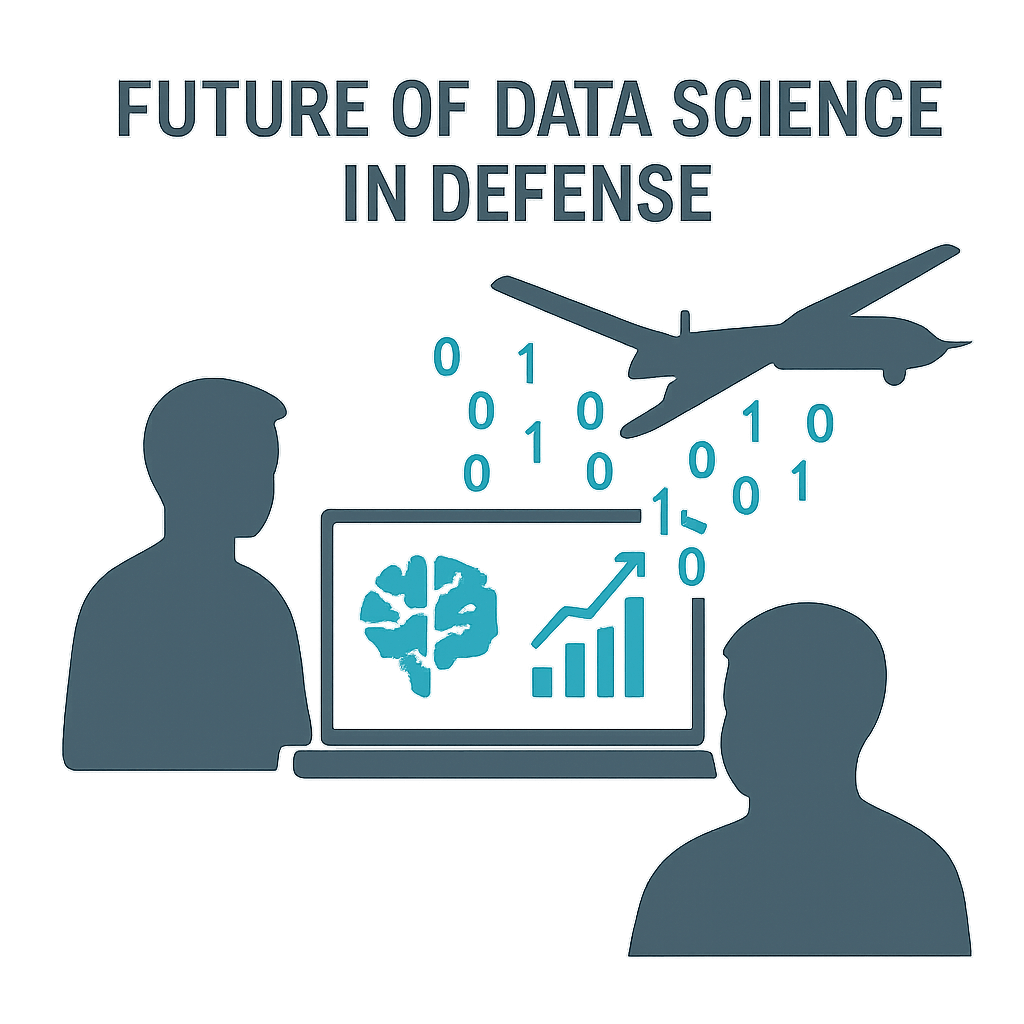
Considering the trends in technology and military operations for the coming decades, it is highly perceivable that data science will continue to play an important role in formulating defense strategies. Military operations will continue evolving and in the coming decades, it will be integration of AI, quantum computing and autonomous systems.
The Role of Quantum Computing in Defense
Defensive communications will be safeguarded via quantum computing, as it is predicted that quantum computing will change the paradigm of cryptography by providing unbreakable encryption. In the same vein, it can make current encryption obsolete, which will thrust countries into a new arms race on quantum technologies.
The Adoption of AI in Strategic Planning
The defense systems of the future will be designed with the capability of integrating AI decision-support systems which will provide the ability to model numerous battlefield scenarios in a matter of seconds. Due to the nature of defense systems, they will be designed to provide maximum certainty and increase the speed of decision-making in highly uncertain and dynamic environments.
The Increasing Role of Autonomous Systems
Drones, robotic combat vehicles, and unmanned submarines will be even more autonomous in the future. They will work in swarm systems with mutual cooperation as sophisticated AI and IoT sensors will be paired with the devices to enable autonomous operations.
Information and Cyber Warfare
With the growing dominance of the battlefield in cyberspace, data science will still remain the tool of choice in the domain of cyber defense and counter-information warfare. Systems that identify deepfakes, misinformation, psychological operations, and other forms of warfare will be valuable in the defense strategy.
Challenges of Adopting Data Science in Defense
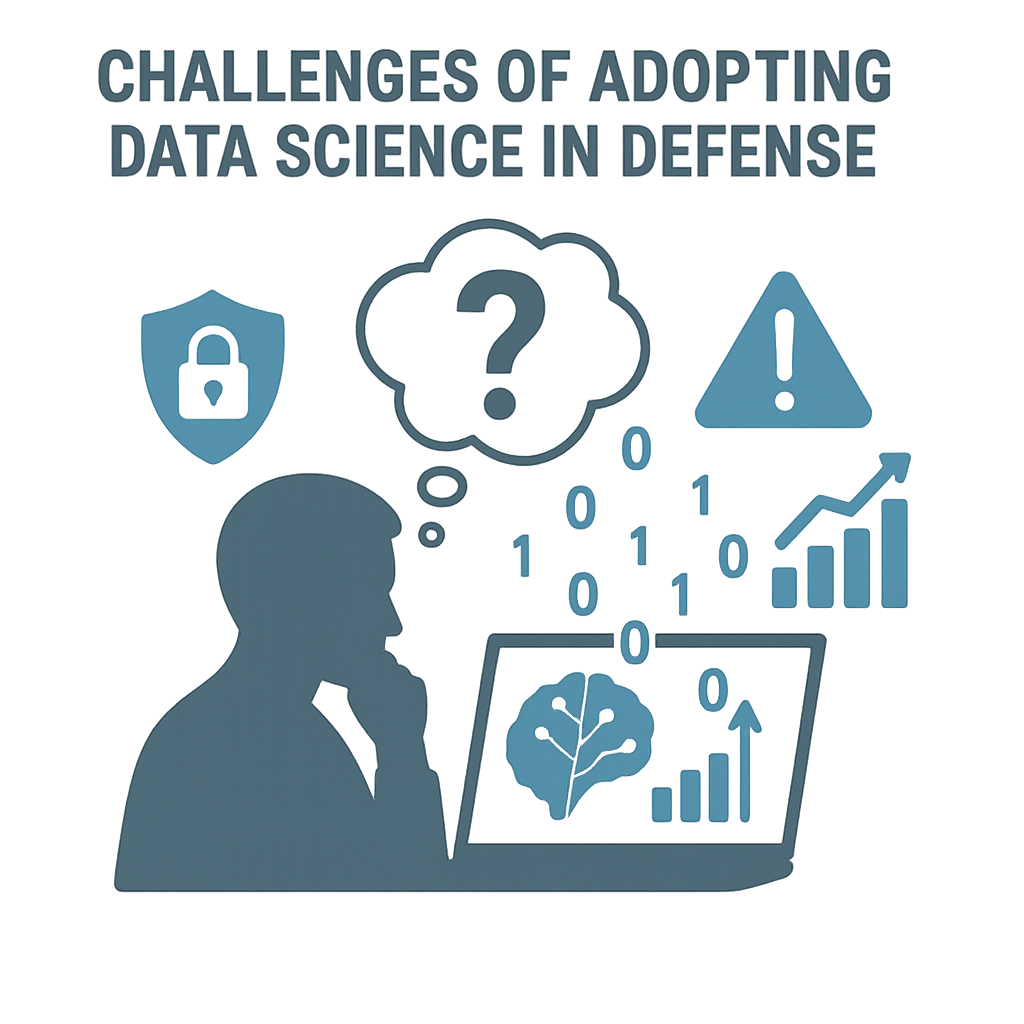
Though data science has revolutionized the defense sector, its implementation is not trouble-free. The adoption of massive analytics, AI-based systems, and predictive models into military operations comes with major challenges pertaining to data security, integration, ethics, and trust.
Data Security and Confidentiality
Military information tends to be kept at top-security levels. To store and analyze it on big data platforms is to invite leaks and unauthorized exposures. Defense cannot risk even a small breach, as it would jeopardize national security. Hence, crafting secure data pipelines, encrypted storage, and restricted access is a huge challenge.
Integration Across Legacy Systems
Defense agencies also have to work with legacy systems, many of which were established decades ago. Bringing new data science tools alongside these legacy systems is a challenging endeavor. A 1980s fighter jet, for instance, might not output data in forms digestible by modern-day AI platforms. This hinders the use of data.
Ethical and Legal Concerns
The deployment of AI-autonomous weapons is a valid topic of serious ethical concerns. Should machines determine life and death? Global laws and agreements are unable to keep pace with the fast development of AI-autonomous defense technology. AI decision-making transparency and accountability are still open questions.
Human Trust in AI Systems
While AI can be used to make better decisions, commanders will always have to rely on these systems. An incorrect forecast would mean lives lost. Establishing human trust in machine-based recommendations takes years of demonstration of dependability, openness, and practice.
In conclusion, embracing data science in defense calls for not just technological progress but also strong policies, legal frameworks, and ethics.
Final Verdict:
Data science has remapped the defense sector, making it a data-intensive ecosystem where data is as potent as weapons. From predictive maintenance to cybersecurity, logistics optimization to autonomous systems, the uses of data science are widespread and significant. Although security, ethical, and trust issues persist, the future of defense will surely be decided by data-driven decision-making.
In contemporary warfare, the country that has control over data essentially has control over the battlefield. Not only does data science fortify national defense, but it also lays the groundwork for the next generation of military innovation.